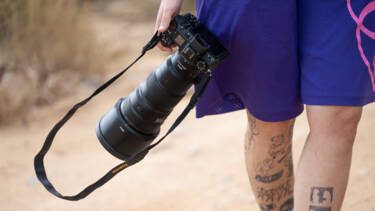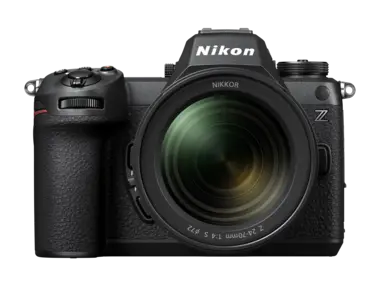How does the new mid-range full-frame camera from Nikon stack up against the Z6II and its pro-level siblings?
The new Nikon Z6III is a powerhouse of a camera for stills and video. Small, agile and packed with creative features, with the famous Nikon build quality and ergonomics, it’s the mid-range camera that is redefining what’s possible at its price point.
But how does it compare to its predecessor, the Nikon Z6II? And how does it compare to the flagship Nikon Z9 and the Z8 – two professional-grade cameras that are used around the world by photographers and filmmakers at the very top of their game? Whether you are seeking to upgrade or a pro looking for a second or third body, what are the key differences, and what are the similarities? Let’s find out…
Nikon Team
Sensors
While the Z8 and Z9 both sport the same 45.7MP fully stacked sensor and the Z6II a non-stacked 24MP sensor, the Z6III has the world’s first partially stacked sensor, delivering big performance from a small body. Partial stacking of the 24.5MP CMOS sensor means incredibly fast sensor scan and data readout speeds, plus AF calculation speeds that are on a par with the Z8 and Z9. It also enables EVF refresh rates of 120fps when shooting at 20fps with the electronic shutter.
Processor
The Z6II is powered by two Expeed 6 processors for fast write speeds and smooth operation. Meanwhile the Z6III, Z8 and Z9 are driven by the Nikon Expeed 7 processor (as is the Nikon Zf), which has ten times the image processing speed of a single Expeed 6. The digital heart of the camera allows for blistering autofocus speeds and features such as subject tracking, high-speed burst shooting and more.
Burst speeds
The Nikon Z6II can shoot up to 14fps RAW, whereas the Nikon Z8 and Z9 can shoot at up to 20fps RAW, and 30, 60 and 120fps in JPEG. The Nikon Z6III can also shoot up to 20fps RAW with the electronic shutter and 14fps with the mechanical shutter. Full size JPEGs can be captured at 60fps and it will still do120fps, with a DX crop.
Video capabilities
The Nikon Z6II can take up to 4K video (full frame at 30p oversampled and DX cropped at 60p) – perfect for many situations. The Z6III has huge capabilities, including 6K/60p recording in camera (no need for an external recording device), 5.4K/60p (great for vertical video), 4K/120p in DX mode and full HD/240p full frame (which will give you fantastic, smooth slow motion). The Z8 and Z9 can shoot up to 8K and are comparable to cinema cameras in their functionality. For most of us, however, the Z6III contains all the video capabilities (and more) we may ever need. And with NIKKOR lenses attached, the results are sharp, cinematic and immersive.
Read more: How to film action videography on the fly with the Nikon Z6III
Autofocus
With the two Expeed 6 processors, the autofocus on the Nikon Z6II is fast and accurate, with AF detection range down to -4.5EV, subject detection for both people and animals, eye detection (again for both people and animals) and subject tracking. The Z6III inherits the amazing autofocus performance of the Nikon Z8 and Z9, with detection for nine types of subject and high AF performance in backlit scenes, all thanks to that Expeed 7 processor. AF detection range is down to -10EV and the autofocus is around 20% faster than the Nikon Z6II. As pro cameras, the Z8 and Z9 sport more focus points (493 to the Z6III’s 273 – or 299 in Auto-area AF and 3D tracking modes) but, aside from that, you’re getting flagship autofocus in a mid-range camera. In fact, the AF density is equal – even a fraction higher – that in the Z8 and Z9!
EVF
Nikon electronic viewfinders are known for their clarity and low-light performance. The EVF on the Z6II is a 3690k-dot display with a 60fps refresh rate, the same great EVF that can also be found on the Nikon Zf. Until the Nikon Z6III came along, the Z8 and Z9 had the brightest EVFs in the industry – known for providing stunning, lifelike visuals. The Z6III has an incredibly smooth EVF view that is almost on par with its pro-level stablemates, and takes the brightness up a level, with a 5670k-dot display that has a maximum brightness of 4000 nits and up to 120fps refresh rate when shooting with the electronic shutter. By comparison, the EVF on the Z9 and Z8 is 3690k-dot with 3000 nits and up to 120fps refresh rate. The EVF on the Z6III is also superior in that it is compatible with the DCI-P3 colour gamut, giving rich and vivid colours without saturation.
Monitors
All four cameras have a 3.2-inch 2100k-dot rear monitor. The Z6II has a two-axis tilting mechanism, the Z8 and Z9 have a vertical/horizontal four-axis tilting mechanism, and the Z6III has a vari-angle mechanism, which is a great choice for vlogging.
Size and weight
The Nikon Z6II is the smallest and lightest of the cameras here, coming in at (w)134 x (h)100.5 x (d)69.5mm and approximately 705g, making it ideal for all-day carrying. The Nikon Z6III is a little larger but packs a lot into a small space. At (w)138.5 x (h)101.5x (d)73.7mm and 750g, it’s a very portable choice either as a main camera or as a second body. The Z8 is bigger at W144 x H118.5 x D83mm and 960g and the Z9, as you would expect for a flagship camera with the incorporated vertical battery grip, is the largest and heaviest of the three, at W149 x H149.5 x D90.5mm and 1,340g.
Which one is for you? The Nikon Z6II is a proven workhorse for stills and video, offering exceptional value for the performance on offer. For many of us, the Nikon Z6III might be all the camera we’ll ever need – even surpassing it in some areas such as the EVF at a mid-range price, amazing video capability, a huge number of creative options for stills and that superfast, world’s first, partially stacked sensor. For pro photographers, the Z8 and Z9 are go-to bodies, but the Z6III, with its familiar control layout, features and extensive custom settings, makes a perfect second (or third) camera. For more on the Nikon Z6III click here.
Discover the Nikon Z 6III
Stills or video, the Nikon Z6III is the partner you’ve been looking for

Unlock greater creativity





